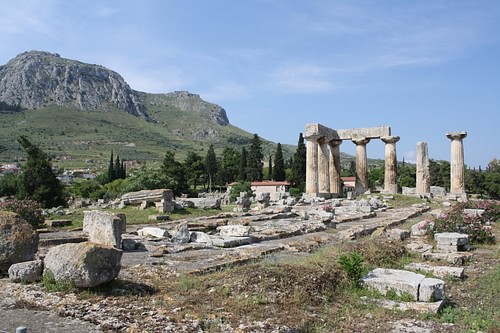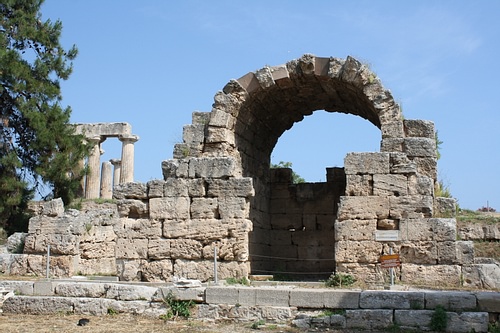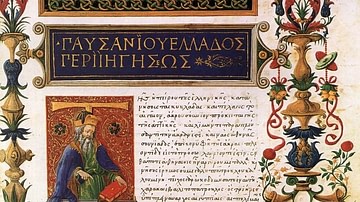
Corinth was a Greek, Hellenistic and Roman city located on the isthmus which connects mainland Greece with the Peloponnese. Surrounded by fertile plains and blessed with natural springs, ancient Corinth was a centre of trade, had a naval fleet and participated in various Greek wars.
In the Roman period, Corinth was a major colony and for over a millennium, it was rarely out of the limelight. The city was famously visited by the Apostle Paul c. 51 CE. Today, the ancient city lies in ruins but there still stands an impressive temple dedicated to Apollo.
Corinth in Mythology
Not being a major Mycenaean centre, Corinth lacks the mythological heritage of other Greek city-states. Nevertheless, the mythical founder of the city was believed to have been King Sisyphus, famed for his punishment in Hades where he was made to forever roll a large boulder up a hill. Sisyphus was succeeded by his son Glaucus and his grandson Bellerophon, whose winged-horse Pegasus became a symbol of the city and a feature of Corinthian coins. Corinth is also the setting for several other episodes from Greek mythology such as Theseus' hunt for the wild boar, Jason settled there with Medea after his adventures looking for the Golden Fleece, and there is the myth of Arion - the real-life and gifted kithara player and resident of Corinth - who was rescued by dolphins after being abducted by pirates.
Historical Overview
First inhabited in the Neolithic period (c. 5000 BCE), the site became more densely populated from the 10th century BCE. The historical founders of the city were the aristocratic descendants of King Bacchis, the Bacchiadae, in c. 750 BCE. These replaced the long line of kings which stretched back in time before historical records. The Bacchiadae ruled as a body of 200 until in c. 657 BCE the popular tyrant Cypselus took control of the city, to be succeeded by his son Periander (re. c. 627-587 BCE). Cypselus funded the building of a treasury at Delphi and founded colonies which included Ambracia, Anactorium, and Leucas. These added to the existing Corinthian colonies of Corcyra (Corfu) and Syracuse in Sicily which had been founded in 734 BCE (traditional date).

From the 8th century BCE, the high quality of Corinthian pottery led to its export across Greece. Indeed, Corinthian pottery, with its innovative figure decoration, would dominate the Greek pottery market until the 6th century BCE when Attic black-figure pottery took over as the dominant style. Other significant exports were Corinthian stone and bronzewares. Corinth also became the hub of trade through the diolkos. This was a stone track with carved grooves for wheeled wagons which offered a land short-cut between the harbours of Lechaion on the Corinthian Gulf and Kenchreai on the Saronic Gulf and probably dates to the reign of Periander. In the Peloponnesian War the diolkos was even used to transport triremes from one sea to the other and it continued to be used until the 9th century CE. Although the idea for a canal across the isthmus was first considered in the 7th century BCE and various Roman Emperors from Julius Caesar to Hadrian began preliminary feasibility studies, it was Nero who actually began the project in 67 CE. However, on the emperor's death, the project was abandoned after three months, not to be resumed until 1881 CE.
From the early 6th century BCE, Corinth administered the Panhellenic games at nearby Isthmia, held every two years in the spring. These games were established in honour of Poseidon and were particularly famous for their horse and chariot races.
An oligarchy, consisting of a council of 80, gained power in Corinth in c. 585 BCE. Concerned with local rival Argos, from c. 550 BCE Corinth became an ally of Sparta. Together, an expedition was launched against Polycrates of Samos in c. 525 BCE but was ultimately unsuccessful. During Cleomenes' reign though, the city became wary of the growing power of Sparta and opposed Spartan intervention in Athens. Corinth also fought in the Persian Wars against the invading forces of Xerxes which threatened the autonomy of all of Greece.
Corinth suffered badly in the First Peloponnesian War, for which it was responsible after attacking Megara. The Corinthians were also instrumental in causing the Second Peloponnesian War, when they felt their regional interests centred in Corcyra were threatened by Athens in 433 BCE. Once again though, the Corinthians, mainly as Sparta's naval ally, had a disastrous war. The city did, however, successfully defend its colony of Syracuse when it was attacked by Athenian forces. Disillusioned with Sparta's reluctance to completely destroy Athens after their victory in the war in 404 BCE and concerned over Spartan expansion in Greece and Asia Minor, Corinth formed an alliance in the 4th century with Argos, Boeotia, Thebes, and Athens to fight Sparta in the Corinthian Wars (395-386 BCE). The conflict was largely fought at sea and on Corinthian territory and was yet another costly endeavour for the citizens of Corinth.
One final conflict, this time against the invading Philip II of Macedon, was once again lost at Chaeronea in 338 BCE. Corinth did become the seat of the Corinthian League, but an unfortunate consequence of this dubious honour was a Macedonian garrison being stationed on the Acrocorinth acropolis overlooking the city. A succession of Hellenistic kings took control of the city - starting with Ptolemy I and ending with Aratus in 243 BCE, when Corinth joined the Achaean League. Worse was to follow, however, when the Roman commander Lucius Mummius sacked the city in 146 BCE.
A brighter period returned to the city when Julius Caesar founded his colony at the site in 44 BCE and organised the agricultural land into organised plots (centuriation) for distribution to Roman settlers. The city was once more flourishing by the 1st century CE and became an important administrative and trade centre. In addition, following St. Paul's visit between 51 and 52 CE, Corinth became the centre of early Christianity in Greece. In a public hearing, the saint had to defend himself against accusations from the city's Hebrews that his preaching undermined the Mosiac Law. The pro-consul Lucius Julius Gallio judged that Paul had not broken any Roman Law and so was permitted to continue his teachings. From the 3rd century CE the city began to decline and the Germanic Heruli and Alaric tribes attacked the city in 267 CE and 396 CE respectively.
The Archaeological Site
In ancient Corinth there were cults to Aphrodite (protectress of the city), Apollo, Demeter Thesmophoros, Hera, Poseidon, and Helios and various buildings to cult heroes, the founders of the city. In addition, there were several sacred springs, the most famous being Peirene. Unfortunately, the destruction in 146 BCE obliterated much of this religious past. In Roman Corinth, Aphrodite, Poseidon, and Demeter did continue to be worshipped along with the Roman gods.
The site today, first excavated in 1892 CE by the Greek Archaeological Service, is dominated by the Doric peripteral Temple of Apollo (c. 550-530 BCE), originally with 6 columns on the façades and fifteen on the long sides. A particular feature of the temple is the use of monolithic columns rather than the more commonly used column drums. Seven columns remain standing today.
The majority of the other surviving buildings date from the 1st century CE in the Roman era and include a large forum, a temple to Octavia, baths, the Bema where St. Paul addressed the Corinthians, the Asklepeion temple to Asclepius, and a centre of healing, fountains - including the monumental Peirine fountain complex (2nd century CE) - a propylaea, theatre, odeion, gymnasium, and stoas. There are also the remains of three basilicas.
Archaeological finds at the site include many fine mosaics - notably the Dionysos mosaic - Greek and Roman sculpture - including an impressive number of busts of Roman rulers - and outstanding examples of all the styles of Greek pottery, the first source of the city's fame in the ancient world.






